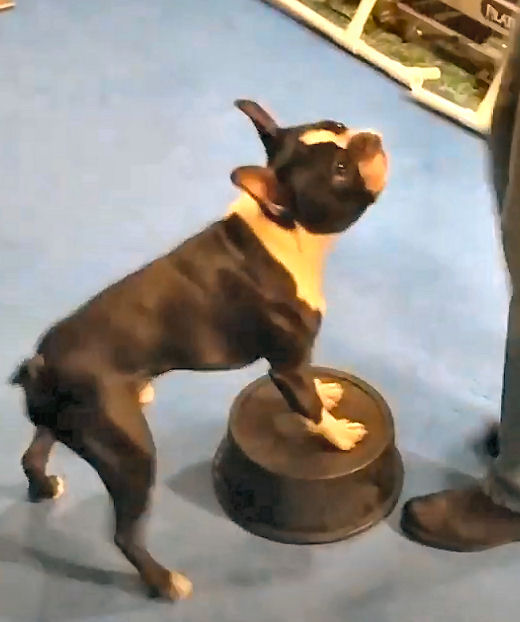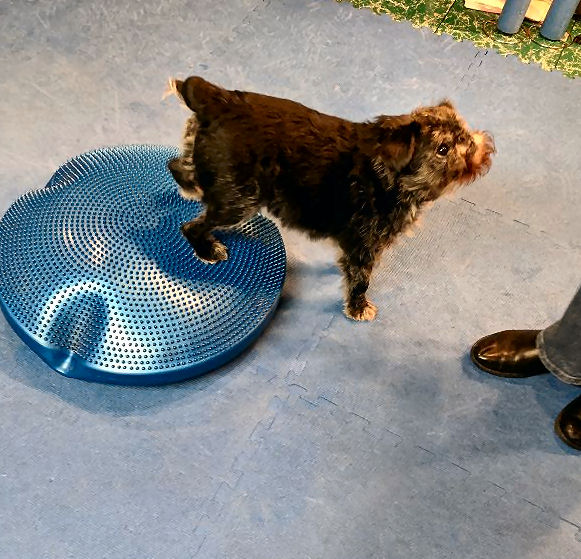Perch work builds dogs’ hind end awareness
Have you ever seen a dog chase its tail – either live or on video? It’s both funny and a little bit sad. Funny because it just is. And sad because most dogs don’t know they have back ends. They lack hind end awareness. They certainly don’t know that the bits back there are able to move independent of the parts up front.
Building hind end awareness and keeping your dog physically fit are two of the best reasons to do “Perch Work” with your dog. It’s also great for teaching tight turns (for Obedience & Rally people), loose-leash walking, and proper heel position. It’s easy to do, doesn’t really need special equipment, and fits easily into a 2-Minute-Dog-Training session. (For more on your dog’s physical fitness and how we can improve it, check out the article, “Wellbeing of dogs – caring for mind and body.”)
What is Perch Work?

At its simplest, Perch Work means the dog has two feet on an elevated surface. They “perch” on some platform. It can be absolutely anything, but not too high. When introducing Perch Work, you shouldn’t use anything more than two to four inches high. We use a 4-inch step stool, but whatever you have will do. If all you’ve got is a couch cushion – that’s fine. The unstable surface will actually benefit the dog’s core strength.
When introducing your dog to their perch, just put it on the floor and let your dog check it out. Looking at it gets a click & reward. Sniffing it is also good. Pawing at it? Great – click and reward. When your dog has done the same thing (look, sniff, paw) three or four times, wait for something more. One paw on the platform is the next step, then two paws.
Since most dogs don’t understand using their back feet and paws, it’s most likely your dog will perch with front feet first.
Next steps
Perch work is one training game where we do use lures to teach the dog what we want. When your dog has two feet on the perch, start moving. If your dog is facing you, it doesn’t matter which way you go. Show your dog a treat and start moving your feet. If your dog swivels to stay at your front, click and reward. Move a little more and wait for your dog to take a step with his/her back feet. If your dog comes off the perch, just wait. When he/she gets two feet back up, click and reward.
The objective is to get your dog to circle the entire perch, front feet up, back feet moving. It may take a couple of sessions to build up to the entire circle. That’s okay. There’s no rush.
Then do it in the other direction. Both sides need equal exercise and tone. Your dog may favor going one way over the other. Just like people, dogs have a dominant side they tend to favor. Be sure to “work” the other side as well.
Different positions
You should also try for Perch Work with your dog next to you. This is the part that helps with those turns for performance sports.
Whichever side your dog is on, hold the treat in the hand further away, so your dog will curve around you to find it. Then put gentle pressure on the dog by stepping slightly into him/her. This will encourage your dog to move those back feet. Again, be sure to work both directions so your dog’s skills develop evenly.
Back feet next
Whatever your dog does with front feet on the perch, they can do with back feet as well. Since this is a very different idea for most dogs, expect it to go somewhat slower.
The easiest way to get your dog to put back feet on the perch is to have them walk across it and click as soon as the back feet are on and front are off. Most dogs will try to get their back feet off as soon as possible. If you’re in front of the dog, try to block the motion and, if the dog is still on the perch, click and reward.
When your dog is comfortable putting back feet only on the perch, start the same circles around, both directions. Click and reward when your dog moves his back feet on the perch.
Name that Perch Work
Decide on different names for the exercises for front feet and back feet. Very uninspired, we call front skills “Feets” and back skills “Rears.” The dogs know what they’re supposed to do. And as long as they’re getting rewarded, they don’t mind a bit.

